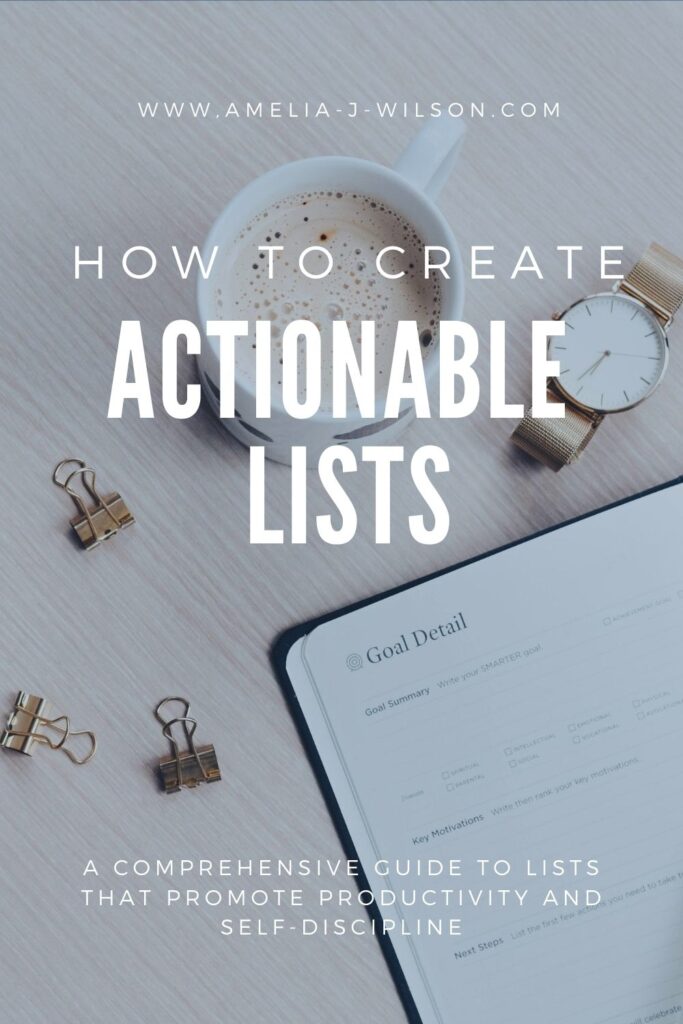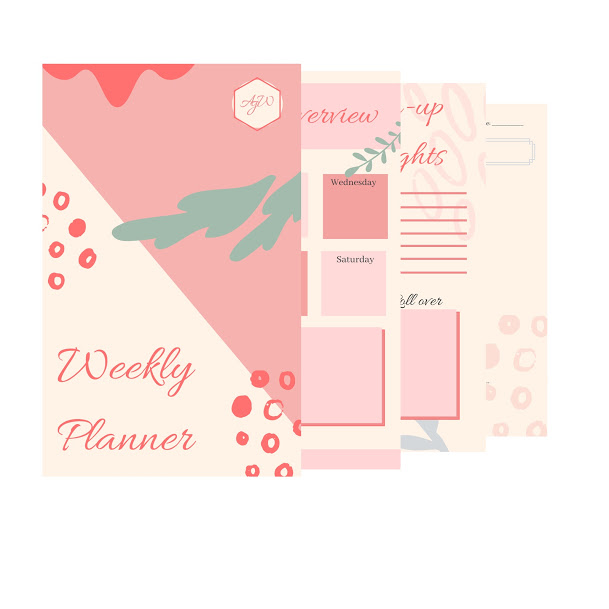For as often as I talk about list making, it’s surprising that I haven’t created a post entirely dedicated to lists! So, I decided to make amends to that and to formulate this post to help you learn how to create actionable lists to help you be productive.
Disclaimer: All of the views and opinions in this post are solely my own and are not sponsored. This post includes affiliate links, meaning I earn a commission through links at no cost to you.

To get started, I wanted to express some of the major benefits of using lists in your day-to-day life. Lists have helped me to become a more self-disciplined, productive, and accountable person. Here’s why:
Lists help you:
- keep track of your chores
- organize your day
- eliminate stress or forgetfulness
- track your habits
- form routines
- form new habits
- get stuff done
- schedule your day by hour
- make long term goals
That’s a lot! The fact that daily list making helps you achieve all of that can be a little mind boggling. Now, you might be thinking “Well, Amelia, lists can’t necessarily help me get stuff done. Something like that requires self-discipline.” And you’d be right.
Self-discipline is needed for any good list to work. The list is useless if you write your tasks down and then completely ignore it. There has to be some sort of internal motivation to actually track yourself and your productivity.
It’s a bit paradoxical though. Because in my experience, lists have helped me to become MORE self-disciplined! I started creating daily lists and since then, I’ve become more accountable for myself.
But let’s venture beyond the benefits of list-making. I want to talk about how to curate lists that get sh*t done!
Figure out if you want daily, weekly, or monthly lists
So, I operate best with all three if I’m being honest. But some people prefer only daily lists or monthly lists. The first step is to decide which kind you want to focus on.
Daily:
Daily lists often repeat…A LOT. They include chores like Grocery Shopping and Doing Dishes. They’re often longer and include more mundane tasks. These are actually my favorite kinds of lists. I enjoy writing out my “to-do’s” the night before and then organizing them by order of importance and by hour in the morning.
Daily lists can be simple and often only include tasks that can get done within a few hours. For longer projects, they are broken up into more bite sized chunks to help you accomplish your tasks over a period of days/a few lists.
Weekly:
Weekly lists are somewhere between short term and long term goals. Often, a whole project is summed up as a task for the list. Mundane chores are also put here because some only need weekly attention. Additionally, weekly lists often include events and dates for outings. This is because they focus more on when things are “due” rather than how much can be done.
I find that freelance work and school work are best listed weekly rather than daily. I write down due dates for each project and then work randomly from there.
Monthly:
Monthly lists, to me, are more like goal setting and affirmations. Monthly lists tend to be short and focus on long term goals. Mine include tasks like:
- finish part two of your WIP
- Finish the current book you’re reading
- Go to _____ event
These goals are more vague and are not meant to be accomplished quickly.
Have a section for “Top 3 Priorities”
Having priorities is the most important aspect of any good list. Some days, I can come up with twenty different tasks I need to do. And some days, I never can quite finish them all. That’s why I put my important (priority) tasks first.
It’s super helpful to tackle your most rewarding projects first and the rest after. I’ve also found that so long as I do my priority tasks, I feel fulfilled with my day, even if they are all I achieve.
Priorities are a great way to feel productive and ward off burnout. You don’t run the risk of overworking yourself and it’s easier to move other tasks into the priority section of your list for the next day.

Set measurable Goals
This can be challenging for some people, myself included. But good lists always have measurabel goals. What do I mean by measureable? Let me give you an idea of some of my goals:
Daily: Write 1,000 words on my WIP
Weekly: Apply to 5 more freelance gigs
Monthly: Gain 5 new email subscribers
See how they each have a number? That’s one way to measure your goals. Another is to use the word “finish” for a task or routine words for habits you have/want to make. So long as you can “measure” your goals and say “Yes. I achieved exactly what I wanted to” or “No. I didn’t achieve exactly what I wanted to” then you’re on the right path.
I think a big part of measurable goals, for me, is having the wherewithal to definitively say yes or no to my ability to achieve a specific goal. Did I do the dishes? Yes. Did I buy groceries? No. That kind of thing. There is no half answer. I can’t say “Yes I did the dishes” if I only washed one plate. Does that make sense?
Make a Habit Tracker
This is another really great part about list making! You get to check off how many times you maintained a streak for a habit you want to make. I include “exercise” on my lists every single day. And each day, I either check it off, or I don’t. Then, I get to go back and look at my lists to see how well I maintained the habit of exercising.
It’s so beneficial to find patterns and see how you’re holding up with your habits. Another habit of mine is to read for an hour every single day. And it’s amazing to see when I’m on a good streak and when I’m not so that I can restructure my life to “fit” that habit!
Organize your list by Activity
If you’ve gone to my shop, then you’ve likely seen the planners I have there. I have quite a few and they’re all organized differently. Sometimes the weekly planners start with Monday, sometimes Sunday. They have different sections for to-do’s, to buy, notes, meals, etc.
Organizing your activities helps you create structure. You can list events separate from chores or meals. You can set groceries in the “buy” category instead of the “task” category. Then you can tackle each category as necessary.
Maybe I’m just a big organizational freak, but I love separating my lists by activity.
Reflect after each list
Going along with habit tracking, reflecting at the end of the day on what you crossed off your list and what you didn’t can help you better understand your own productivity and motivation. It adds to your sense of self-discipline and promotes your ability to think interpersonally.
Reflecting also allows you to “catch up” on missed items and to re-organize your days, weeks, months as you see fit.
If you like this post, check out some similar posts of mine below:
Feel free to leave a comment below and let me know how you make your lists!
You can also email me with questions or concerns you may have at info.amelia.wilson@gmail.com
Also, check out my poetry book, The Lights are on but Nobody’s Home, available now on amazon for $6.99!
Disclaimer: All of the views and opinions in this post are solely my own and are not sponsored. This post includes affiliate links, meaning I earn a commission through links at no cost to you.
Thanks again


